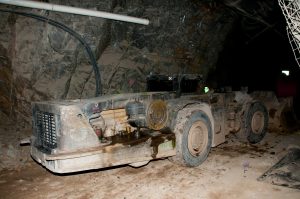Print a Sign-In Sheet | Spanish Version Coming Soon
There are important safety rules when riding in or operating a mantrip in underground mines.
- Always perform pre-operational checks to ensure safe operating conditions.
- Always make sure the mantrip has come to a complete stop before mounting and dismounting. Ensure that all employees who are riding the mantrip are seated and remain seated until the mantrip comes to a complete stop.
- No horseplay while on the mantrip. Many miners have been injured because of horseplay while riding or operating a mantrip.
- Drive at safe speeds. When roadways are in poor condition, use lower speeds than normal. Watch for objects that may have fallen from a supply car or roof and ribs that may have fallen into the roadways. Look for dips and rolls or low spots and slow down before approaching these areas so others can prepare to react and keep all body parts inside of the moving mantrip.
- Watch for oncoming traffic, slow down at intersections where roadways meet. Be courteous. Scoops may have supply cars preventing them from yielding to oncoming traffic. If you encounter a scoop, give the right of way and try to park on the operator’s side of the scoop so you can be seen by the operator.
- Watch out for others in the mantrip and be aware that their safety is in your hands while you operate the mantrip.
- Keep a good distance from other trips in front of you and give yourself enough time to stop in case something should fall off the ride in front of you.
- Always make sure the mantrip is in the “PARK” position, set the parking brake, and scotch the wheels before leaving the ride.
- Communicate your intentions and warn others of close areas, especially when you are backing up.
- Never leave the mantrip idling; turn the engine off before dismounting.
- Never put yourself in a pinch point by walking between a mantrip and another piece of equipment or rib.
KEMI does not assume liability for the content of information contained herein. Safety and health remain your responsibility. This information is to be used for informational purposes only and not intended to be exhaustive or a substitute for proper training, supervision, or manufacturers’ instructions/recommendations. KEMI, by publication of this information, does not assume liability for damage or injury arising from reliance upon it. Compliance with this information is not a guarantee or warranty that you will be in conformity with any laws or regulations nor does it ensure the absolute safety of any person, place, or object, including, but not limited to, you, your occupation, employees, customers, or place of business.

